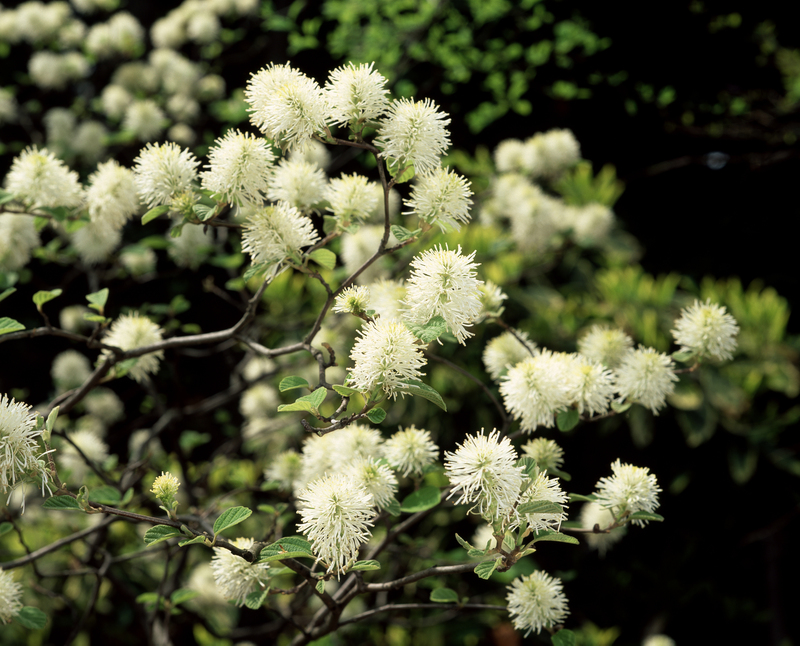Keeping Garden Plants Safe During Frosty Winters
Posted on 20/09/2025
Keeping Garden Plants Safe During Frosty Winters: An Expert Guide
Winter presents unique challenges for gardeners. Sudden temperature drops, harsh winds, and persistent frost can easily threaten even the hardiest of garden plants. The good news is there are many effective ways to protect plants from frost in winter and ensure your greenery emerges healthy when spring returns.
In this comprehensive article, we'll dive deep into what frost means for your garden, how to recognize vulnerable plants, and the most effective techniques for keeping garden plants safe during frosty winters. Whether you're a seasoned horticulturist or a casual home gardener, this guide offers valuable strategies, tips, and insights to shield your plants against winter's chill.

Understanding Frost and Its Impacts on Garden Plants
Frost occurs when air temperatures near ground level drop low enough for water vapor to condense and freeze on surfaces like leaves and stems. This typically happens on clear, still nights when heat escapes rapidly from the earth's surface. Winter frost may seem picturesque, but it can be extremely damaging to tender plants.
Types of Frost That Threaten Your Garden
- Radiation Frost: Forms on clear nights when the ground loses heat rapidly. Common in calm, dry winter weather.
- Advective Frost: Brought by icy winds and rapid cold fronts, advective frost can cover larger areas and be even more dangerous for garden plants in winter.
- Hoar Frost: Appears as feathery ice crystals, less damaging but still dangerous in repeated spells.
How Does Frost Damage Plants?
When frost settles on plants, the water within and between the plant cells freezes. This expansion can rupture cell walls, causing leaf wilting, blackened foliage, mushy stems, and in severe cases, plant death. Young, tender, or new growth is especially vulnerable, but even established perennials can suffer during prolonged cold.
Identifying Vulnerable Garden Plants
Not all plants are equally susceptible to frost. Some varieties are naturally hardy, while others need protection to survive the cold. Early recognition is key to protecting garden plants during frosty weather.
Plants Most At Risk During Winter
- Tropical and Subtropical Plants: Ferns, Bougainvillea, Hibiscus, and Banana Plants.
- Annuals and Tender Perennials: Geraniums, Impatiens, Petunias, Marigolds.
- Fruit and Vegetable Plants: Tomatoes, Peppers, Citrus Trees, Strawberries.
- Succulents and Cacti: Despite drought tolerance, many are frost-sensitive.
Conversely, native plants, evergreens, and many bulbs are better adapted to survive cold and frost. However, sudden freeze events can still catch even hardy species off-guard.
Proven Strategies for Keeping Garden Plants Safe During Frosty Winters
Effective winter plant care starts with preparation and the right preventative measures. Below are the most reliable and practical ways to shield your plants against the frost, based on both traditional wisdom and modern gardening science.
1. Choose the Right Plant Location
- Plant the most sensitive species near walls, fences, or other structures--they act as heat banks, keeping plants slightly warmer overnight.
- Avoid low-lying areas or hollows, since cold air sinks and frost tends to settle there.
- Group tender plants together for easier protection and to create a localized microclimate.
2. Mulch for Insulation
Adding a thick layer of mulch is a classic and effective way to protect garden plants from frost:
- Use organic materials like straw, leaves, wood chips, or compost. Lay it at least 2-4 inches deep around the base (avoiding direct stem contact).
- Mulch retains soil warmth, reduces moisture loss, and shields roots from temperature extremes.
- For extra protection, add insulation such as cardboard or hessian sacking under the mulch during severe cold snaps.
3. Cover Up Sensitive Plants
On frosty nights, an easy method for keeping garden plants safe in winter is to physically cover them. Try these covering options:
- Frost cloths: Specifically designed lightweight, breathable fabrics that trap ground heat but allow moisture and light through.
- Old bed sheets, burlap, or newspaper: Great in a pinch for overnight protection. Anchor the edges to the ground to prevent wind from blowing covers away.
- Plastic sheeting: Only recommended if kept off leaves (use stakes or hoops) to avoid condensation damage.
- Always remove covers during the day to let in sunlight and avoid overheating.
4. Watering Wisely Before a Frost
Moist soil retains more heat than dry soil. Water garden beds and pots a day before an expected frost to increase soil warmth. Avoid wetting leaves in the evening, which can lead to ice formation. Well-hydrated roots are also less susceptible to cold stress.
5. Utilize Cloches, Cold Frames, and Mini-Greenhouses
- Cloche: A bell-shaped glass or plastic cover placed over individual plants to trap warmth.
- Cold frame: A low, clear-roofed enclosure for multiple plants--perfect for overwintering herbs, veggies, and young seedlings.
- Mini-greenhouses: Tall, clear shelters that work for both small and medium-sized plants.
These structures warm up during the day from sunlight, keeping temperatures several degrees warmer than open garden beds at night. Ventilate during sunny days to avoid overheating!
6. Move Container Plants Indoors or to Sheltered Areas
Potted plants can be particularly vulnerable since their roots are exposed and the soil can freeze faster. Strategies include:
- Bringing delicate containers inside overnight or during severe cold spells.
- Grouping pots together, close to the south or west-facing walls for extra warmth.
- Wrapping pots with bubble wrap, burlap, or fabric to insulate roots from freezing conditions.
7. Pruning and Cutting Back - Caution Needed
It's a common mistake to prune garden plants in fall to tidy up the shape. However, avoid heavy pruning before or during winter. Why?
- Pruning stimulates new, tender growth, which is much more likely to be damaged by frost.
- Leave some faded stems and foliage; they can help insulate lower branches and roots.
- Wait until spring to prune plants that are not frost-hardy.
8. Harness Natural Heat Sources
- Use water bottles or jugs filled with warm water and place them around your most precious plants at sunset. As the water releases heat overnight, it can slightly raise temperatures and reduce freeze damage.
- Even rocks and bricks collect heat during the day--position these thoughtfully to help buffer nearby plants.
9. Embrace Anti-Frost Sprays
Some gardeners use anti-transpirant sprays (also called anti-frost sprays) to form a temporary shield on plant leaves, reducing moisture loss and minimizing frostbite damage. Follow the manufacturer's instructions, and use only on recommended plant types.
Special Tips for Edible Gardens and Fruit Trees
Orchard plants, herbs, and winter vegetables often require extra TLC to survive frosts.
Frost Protection for Fruit Trees
- Whitewashing trunks: Coat the trunks with a 1:1 mixture of water and white latex paint to prevent cracking from temperature fluctuations.
- Use tree wraps or insulation: Wrap young or citrus trees with breathable fabric or cardboard tubes for added protection.
Safeguarding Winter Vegetables and Herbs
- Install mini-tunnels with plastic or netting over winter crops like lettuce, spinach, and kale.
- Harvest leafy crops before severe frosts--but root crops like carrots can often be left insulated in the ground under mulch.
- Move delicate potted herbs to a sunny indoor windowsill until spring.
Common Mistakes to Avoid When Protecting Plants from Frost
- Using plastic covers directly on plants: This can trap moisture and cause leaves to stick and freeze. Always create an air space between plastic and foliage.
- Watering at night: Wet foliage can freeze faster, so stick to early morning watering routines.
- Leaving covers on all day: Plants need sunlight and airflow to avoid mold and rot.
- Ignoring potted plants: Container roots are vulnerable--insulate or move them as needed!
Creating a Year-Round Frost-Resilient Garden
With smart planning, you can build a frost-resistant garden that thrives even during the coldest winters. Here's how:
- Choose native, cold-hardy species for foundational plantings.
- Mix evergreens, ornamental grasses, and winter-flowering perennials to maintain garden interest.
- Position frost-sensitive plants in protected spots, such as courtyards or under larger trees.
- Incorporate raised beds for better drainage and warmer root zones.
Long-Term Investments: Greenhouses and Heating Solutions
- If you're serious about year-round gardening, consider installing a greenhouse with heating mats or electric heaters for valuable specimens.
- Soil cables and frost protection heaters are available for flower beds, but always follow safety guidelines.

FAQs About Keeping Garden Plants Safe During Frosty Winters
1. How cold is too cold for garden plants?
It depends on the plant species. Many hardy plants cope with light frosts down to -3?C (27?F), but tender tropicals can suffer damage just below 0?C (32?F). Check your plant labels and local frost dates.
2. Should I fertilize before winter?
No. Fertilizing late in the season encourages new, soft growth that's easily damaged by frost. Hold off on feeding until early spring.
3. What's the best frost protection method?
A combination is most effective: Mulch, timely covering, strategic watering, and choosing frost-tolerant varieties.
Conclusion: Give Your Garden a Head Start This Winter
Protecting your plants from frost isn't just about saving garden aesthetics--it means preserving years of work, investment, and enjoyment. By preparing in advance, choosing the right plant placements, and applying proven protection methods, you'll ensure your garden not only survives but flourishes after the coldest months.
As each winter approaches, revisit these strategies. With a little planning, you can look forward to a lush and thriving garden as soon as the first spring thaw. Proactive frost protection for garden plants is the key to gardening success through every season!
- Stay vigilant about weather forecasts
- Be ready to cover or move vulnerable plants on short notice
- Experiment with mulch types and covers to find what works best in your region
Wishing you a safe, vibrant, and resilient garden through every frosty winter!

